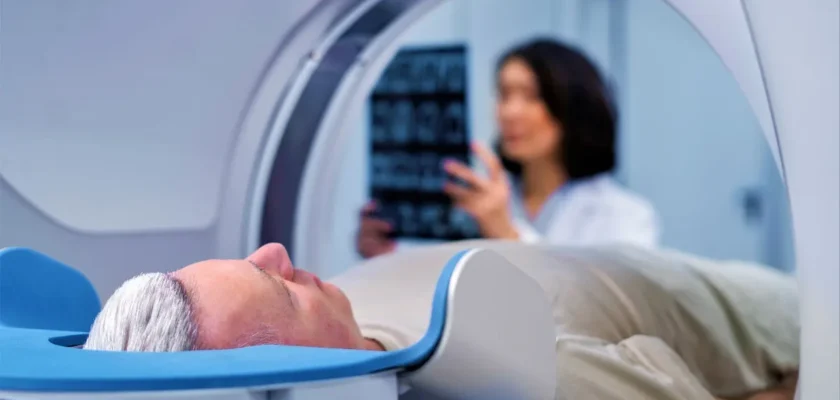Pancreatic cancer is a formidable adversary, known for its aggressive nature and limited treatment options. Over the years, medical science has made significant strides in the battle against cancer, with proton therapy emerging as a promising radiation treatment
This article will explore the effectiveness of proton therapy for pancreatic cancer and its potential advantages over conventional radiation therapy.
Understanding Proton Therapy
Proton therapy is a cutting-edge radiation treatment that utilizes high-energy protons to target and destroy cancer cells. Unlike traditional radiation therapy, which uses X-rays, protons deposit most of their energy precisely at the tumor site, minimizing damage to surrounding healthy tissues. This precision makes proton therapy particularly attractive for treating cancers in sensitive and hard-to-reach areas, such as the pancreas.
Challenges in Pancreatic Cancer Treatment:
Pancreatic cancer is highly challenging to treat due to its location deep within the abdomen and its tendency to spread rapidly. Surgery, chemotherapy, and conventional radiation therapy have been the mainstays of treatment, but they often come with significant side effects and varying success rates.
Proton therapy offers a ray of hope, as it allows for targeted treatment with reduced collateral damage, potentially improving outcomes and quality of life for patients.
The Advantages of Proton Therapy:
Reduced Damage to Healthy Tissues: Unlike traditional radiation, proton therapy can spare critical organs near the pancreas, such as the liver, kidneys, and intestines. Preserving healthy tissue leads to less side effects and may decrease the risk of secondary problems.
Higher Doses to the Tumor: This therapy activates higher radiation doses to be deliver directly to the tumor with minimizing exposure to adjacent healthy tissues. This may result in better tumor control and improved chances of local tumor eradication.
Suitable for Previously Treated Patients: Patients who have already received radiation therapy for other cancers or have undergone prior surgery may still be candidates for proton therapy. The precision of proton beams allows for re-irradiation with reduced risks of overlapping toxicities.
Combination Therapy Potential: Proton therapy can be combined with other treatments, such as chemotherapy, immunotherapy, or surgery, to create a comprehensive and personalized treatment plan for each patient’s specific needs.
Clinical Evidence:
While proton therapy shows great promise, rigorous clinical trials comparing it directly to conventional radiation therapy for pancreatic cancer are relatively limited due to the novelty of the treatment.
However, initial studies and anecdotal evidence have shown encouraging results.
In a study published in the International Journal of Radiation Oncology, Biology, and Physics, researchers reported that pancreatic cancer patients treated with proton therapy had a significantly lower incidence of gastrointestinal side effects compared to those who underwent conventional radiation therapy.
Additionally, proton therapy demonstrated excellent tumor control rates in a study conducted at the University of Florida Proton Therapy Institute.
Considerations and Challenges:
Cost and Accessibility: Proton therapy requires specialized facilities and equipment, making it less widely available than traditional radiation therapy. Moreover, the cost of treatment may be a significant barrier for some patients.
Limited Long-term Data: As proton therapy is a relatively new treatment modality, long-term data on its effectiveness in treating pancreatic cancer are still evolving. More research and longer follow-up periods are needed to draw definitive conclusions.
Patient Selection: Not all pancreatic cancer patients may benefit equally from proton therapy. The treatment’s efficacy depends on the tumor’s location, size, and stage, as well as the patient’s overall health.
Proton therapy holds great potential as a valuable tool in the fight against pancreatic cancer. Its precision, ability to spare healthy tissues, and compatibility with other treatment modalities make it an attractive option for patients with this challenging disease.
While further research is necessary to solidify the position of proton therapy for pancreatic cancer, its early success and promising results offer hope for improved outcomes and quality of life for patients facing this formidable foe. As technology advances and accessibility increases, proton therapy may become an increasingly integral part of multidisciplinary cancer care.
At What Stage Proton Therapy Mostly Effective
Doctors usually recommend 2B to 4 stage cancer where it is not possible to remove the complete cancer tissues. Sometimes doctors may perform Proton Therapy During, before or after surgery and they may combine it with chemotherapy too.
Metastatic pancreatic cancer: Where cancer is spread to other organs
Borderline resectable pancreatic cancer: Where the cancer is grown to nearby organs, blood vessels, tissues, and it may not be treated even with surgery.
Locally advanced pancreatic cancer: Where cancer is spread to nearby blood vessels or even lymph nodes.
Recurrent pancreatic cancer: Where cancer is back after the first treatment. It may return to the pancreas where it has started, or even at other parts.
Takeaways
Pancreatic cancer has an overall 11% survival rate. The survival rate between 2011 and 2017 is a 5 year overall period, however such proton therapy is constantly evolving and helping to improve the chances of living a long life with such type of cancer.

